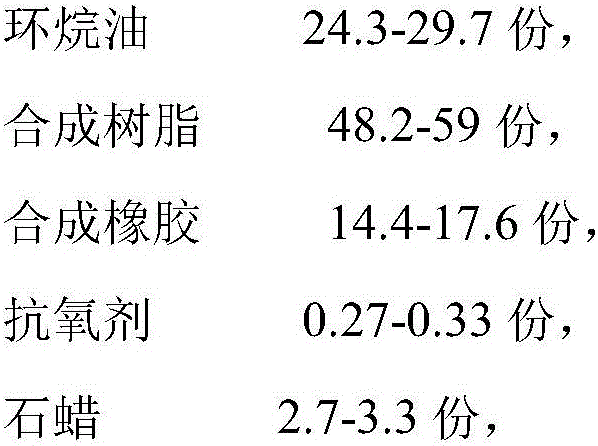Structural adhesive used for compositing sanitary napkin PE membrane and non-woven fabrics and preparation method thereof
A technology for sanitary napkins and non-woven fabrics is applied in the field of composite structural adhesives for sanitary napkin PE films and non-woven fabrics and their preparation, which can solve the problems of expensive metallocene polyolefin raw materials and high production costs, and achieve reduced viscosity and flow performance. The effect of enhancing, increasing liquidity
- Summary
- Abstract
- Description
- Claims
- Application Information
AI Technical Summary
Problems solved by technology
Method used
Image
Examples
Embodiment 1
[0041] The specific process of preparing structural adhesive for sanitary napkin PE film and non-woven fabric is as follows:
[0042] Step 1: Set the temperature of the reactor to 100°C, then add 27 g of naphthenic oil and stir for 10 minutes at a rotation speed of 60 rpm.
[0043] Step 2: The reactor continues to heat up to the first stage temperature of 120°C, add 10.6g SBS792, 2.7g SBS188, 2.7g SIS1105 and 3g paraffin, and continue stirring for 90 minutes at a speed of 60 revolutions / min.
[0044] Step 3: Continue to heat the reactor until the second stage temperature is 140℃, add 43.6g pentaerythritol resin, 10g C5 petroleum resin, 0.15g antioxidant 1010 and 0.15g antioxidant 1076, and stir at 200 rpm for 20 minutes .
[0045] Step 4: The obtained product is discharged after vacuuming for 10 minutes, and is filtered twice through a filter cover with a pore size of 1 cm and a filter cloth bag of 300 meshes, and then placed in a container to cool to room temperature and encapsulate....
Embodiment 2-7
[0048] The process flow in the following embodiments is similar to that of the first embodiment, and the difference lies only in the ratio of the components and the process parameters. The quality of each component in Example 1 and the following examples is shown in Table 2. The process parameters involved in the first embodiment and the following embodiments are shown in Table 3.
[0049] Table 2 The quality of each component in Example 1 to Example 7
[0050]
[0051] Table 3 Process parameters involved in Example 1 to Example 7
[0052]
[0053] Table 4 Comparison of performance test results of the structural adhesives prepared in Example 1 to Example 7
[0054]
[0055] Based on the above test results, Example 1 has better performance, heating to 120 ℃ and 160 ℃, moderate viscosity, no carbonization occurs, the operating temperature during processing is suitable for 120-140 ℃, and reduces the use temperature of structural adhesive Therefore, Example 1 is a more preferred solutio...
PUM
| Property | Measurement | Unit |
|---|---|---|
| Softening point | aaaaa | aaaaa |
| Viscosity | aaaaa | aaaaa |
| Viscosity | aaaaa | aaaaa |
Abstract
Description
Claims
Application Information
 Login to View More
Login to View More - R&D
- Intellectual Property
- Life Sciences
- Materials
- Tech Scout
- Unparalleled Data Quality
- Higher Quality Content
- 60% Fewer Hallucinations
Browse by: Latest US Patents, China's latest patents, Technical Efficacy Thesaurus, Application Domain, Technology Topic, Popular Technical Reports.
© 2025 PatSnap. All rights reserved.Legal|Privacy policy|Modern Slavery Act Transparency Statement|Sitemap|About US| Contact US: help@patsnap.com



